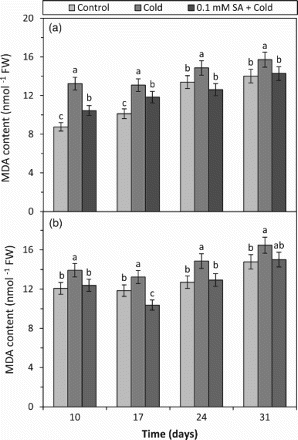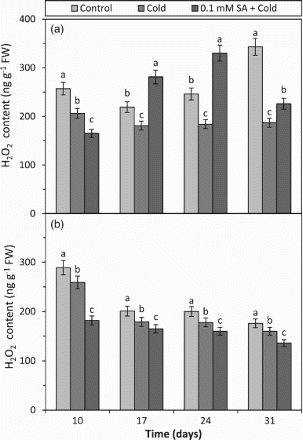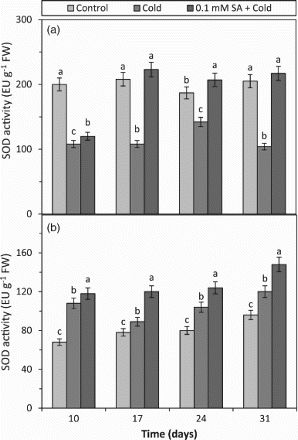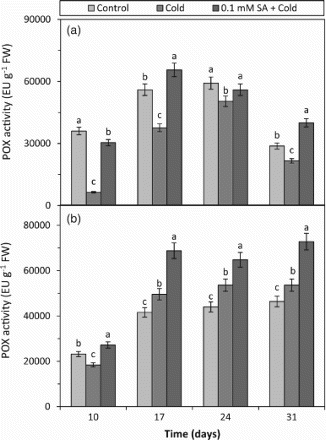Figures & data
Figure 1. The effects of cold and SA + cold treatments on the MDA content in the leaves of two barley cultivars differing at cold tolerance. (a) Cold-tolerant cultivar; Tokak and (b) cold-sensitive cultivar; Akhisar): each datum is the average of six independent samples (n = 6). Values in a group followed by the same letter are not statistically different at P < .05 level as determined by Duncan's Multiple Range Test. Each value in the graph shows average of three experiments. Vertical bars represent ± SE.

Figure 2. The effects of cold and SA + cold treatments on H2O2 content in the leaves of two barley cultivars differing at cold tolerance. (a) Cold-tolerant cultivar; Tokak and (b) cold-sensitive cultivar; Akhisar. Each datum is the average of six independent samples (n = 6). Values in a group followed by the same letter are not statistically different at P < .05 level as determined by Duncan's Multiple Range Test. Each value in the graph shows the average of three experiments. Vertical bars represent ± SE.

Figure 3. The effects of cold and SA + cold treatments on SOD activity in the leaves of two barley cultivars differing at cold tolerance. (a) Cold-tolerant cultivar; Tokak and (b) cold-sensitive cultivar; Akhisar. Each datum is the average of six independent samples (n = 6). Values in a group followed by the same letter are not statistically different at P <.05 level as determined by Duncan's Multiple Range Test. Each value in the graph shows the average of three experiments. Vertical bars represent ± SE.

Figure 4. The effects of cold and SA + cold treatments on the CAT activity in the leaves of two barley cultivars differing at cold tolerance. (a) Cold-tolerant cultivar; Tokak and (b) cold-sensitive cultivar; Akhisar. Each datum is the average of six independent samples (n = 6). Values in a group followed by the same letter are not statistically different at P < .05 level as determined by Duncan's Multiple Range Test. Each value in the graph shows the average of three experiments. Vertical bars represent ± SE.

Figure 5. The effects of cold and SA + cold treatments on POX activity in the leaves of two barley cultivars differing at cold tolerance. (a) Cold-tolerant cultivar; Tokak and (b) Cold-sensitive cultivar; Akhisar. Each datum is the average of six independent samples (n = 6). Values in a group followed by the same letter are not statistically different at P < .05 level as determined by Duncan's Multiple Range Test. Each value in the graph shows the average of three experiments. Vertical bars represent ± SE.

Figure 6. The effects of cold treatment on endogenous SA content in the leaves of two barley cultivars differing at cold tolerance. (a) Cold-tolerant cultivar; Tokak and (b) Cold-sensitive cultivar; Akhisar. Each datum is the average of six independent samples (n = 6). Values in a group followed by the same letter are not statistically different at P < .05 level as determined by Duncan's Multiple Range Test. Each value in the graph shows the average of three experiments. Vertical bars represent ± SE.

